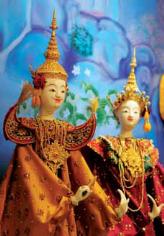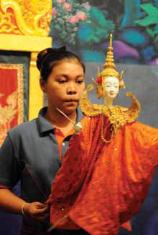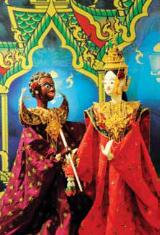Basic HTML Version





สาขาศิ
ลปะการแสดง
มรดกภู
มิ
ปั
ญญาทางวั
ฒนธรรม
40
Phra Aphai Mani , which is the most popular
of all, Laksanawong, Sang Thong, Krai Thong,
Kaeo Na Ma, and Suwannahong. The custom for
presentation requires that, before the show begins,
the Master of Ceremony puppet must come out to
perform the Wai Khru (paying homage to the teacher)
dance to the Phleng Cha Pi, Pin Taling Nok and Phleng
Na Phat Rua Sam La tunes.
The bamboo puppet theatre requires a stage
and set with a screen to hide from the spectator’s
view the puppeteers, who manipulate the puppets
and deliver the dialogue, the musicians and the
singers. The backdrop might depict any scene
that the t roupe prefers , wi th two doors on
both sides for the puppets’ entrance and exit.
The lower part of the stage has a screen to hide the
puppeteers’ hands.
After the first bamboo puppet theatre was
introduced to the Bangkok audience in King Rama V’s
reign, several puppet troupes mushroomed and became
popular, namely Prince Suthat’s troupe, Prince Anuson’s
troupe, Chang Wang To’s troupe, Chang Wang Thua’s
troupe, Nai Wing’s troupe, and Nai Piak’s troupe.
Nai Piak’s troup, in particular, was passed on to his
descendant, National Artist Chuen Sakun-kaeo,
who transmi ts the puppet presentat ion and
manipulation technique to those who are interested
in the puppeteer’s art today.
There are numerous other puppet troupes
in Bangkok and upcount ry, such as the Rot
Siri-ninsin’s troupe, Khru Wong’s troupe, Yai Sarai’s
troupe, Ta Dat’s troupe, and Mae Chaweng’s troupe,
the Fine Arts Department’s troupe, Khun Rat’s troupe,
Khru Kai’s troupe, Ban Tuktun’s troupe, Ban Dontri’s
troupe, and the puppet troupe of Mr Chakkraphan
Posayakrit, National Artist in the Fine Arts category in
2000.
A kind of entertainment that used to enjoy wide
popularity, puppet theatre is rarely seen today. With
the flood of new kinds of entertainment today, the
puppet theatre can only attract some limited groups
of true enthusiasts.

